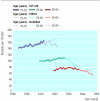Effect of NHS breast screening programme on mortality from breast cancer in England and Wales, 1990-8: comparison of observed with predicted mortality
- PMID: 10987769
- PMCID: PMC27479
- DOI: 10.1136/bmj.321.7262.665
Effect of NHS breast screening programme on mortality from breast cancer in England and Wales, 1990-8: comparison of observed with predicted mortality
Abstract
Objective: To assess the impact of the NHS breast screening programme on mortality from breast cancer in women aged 55-69 years over the period 1990-8.
Design: Age cohort model with data for 1971-89 used to predict mortality for 1990-8 with assumption of no major effect from screening or improvements in treatment until after 1989. Effect of screening and other factors on mortality estimated by comparing three year moving averages of observed mortality with those predicted (by five year age groups from 50-54 to 75-79), the effect of screening being restricted to certain age groups.
Setting: England and Wales.
Subjects: Women aged 40 to 79 years.
Results: Compared with predicted mortality in the absence of screening or other effects the total reduction in mortality from breast cancer in 1998 in women aged 55-69 was estimated as 21.3%. Direct effect of screening was estimated as 6.4% (range of estimates from 5.4-11.8%). Effect of all other factors (improved treatment with tamoxifen and chemotherapy, and earlier presentation outside the screening programme) was estimated as 14.9% (range 12.2-14.9%).
Conclusions: By 1998 both screening and other factors, including improvements in treatment, had resulted in substantial reductions in mortality from breast cancer. Many deaths in the 1990s will be of women diagnosed in the 1980s and early 1990s, before invitation to screening. Further major effects from screening and treatment are expected, which together with cohort effects should result in further substantial reductions in mortality from breast cancer, particularly for women aged 55-69, over the next 10 years.
Figures
Comment in
-
Acquisition of host antigens by young Schistosoma mansoni in mice: correlation with failure to bind antibody in vitro.Parasitology. 1975 Feb;70(1):67-75. doi: 10.1017/s0031182000048873. Parasitology. 1975. PMID: 1118189
-
How effective is screening for breast cancer?BMJ. 2000 Sep 16;321(7262):647-8. doi: 10.1136/bmj.321.7262.647. BMJ. 2000. PMID: 10987748 Free PMC article. No abstract available.
-
Effect of screening programme on mortality from breast cancer. Benefit of 30% may be substantial overestimate.BMJ. 2000 Dec 16;321(7275):1527. BMJ. 2000. PMID: 11118187 Free PMC article. No abstract available.
-
Effect of screening programme on mortality from breast cancer. Women might not accept mammography if benefit is lower than is currently thought.BMJ. 2000 Dec 16;321(7275):1527-8. BMJ. 2000. PMID: 11118188 No abstract available.
References
-
- Forrest APM. Breast cancer screening: report to the health ministers of England, Wales, Scotland and Northern Ireland. London: HMSO; 1986.
-
- Department of Health. The health of the nation: a strategy for health in England. London: HMSO; 1992.
-
- Coleman MP, Babb P, Damiecki P, Groscalude P, Honjo S, Jones J, et al. Cancer survival trends in England and Wales 1971-1995: deprivation and NHS region. London: Stationery Office; 1999. . (Studies in medical population subjects No 61.)
-
- Tabar L, Fagerberg CJ, Gad A, Baldetorp L, Holmberg LH, Grontoft O, et al. Reduction in mortality from breast cancer after mass screening with mammography. Randomised trial from the breast cancer screening working group of the Swedish National Board of Health and Welfare. Lancet. 1985;i:829–832. - PubMed
Publication types
MeSH terms
Substances
LinkOut - more resources
Full Text Sources
Other Literature Sources
Medical


